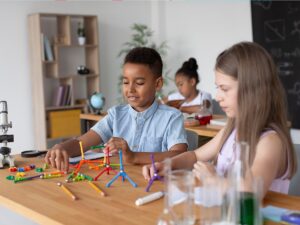In today’s fast-paced digital world, toddlers are growing up surrounded by screens—from smartphones and tablets to smart TVs and virtual assistants. While technology can open up a world of learning opportunities, it also poses some serious challenges. So, how do we as parents and educators strike the right balance?
Let’s explore the ups and downs of toddlers and tech, and how schools like Tinkerbelle, one of the Best CBSE Schools in Panchkula, are leading the way in supporting digital-age parenting.
The Digital Age and Our Youngest Learners
Toddlers and Tech Exposure: What Research Says
Studies show that the average toddler in India spends 1–3 hours a day on screens. That’s a lot, considering their growing brains are still developing key skills like attention, memory, and emotional regulation.
Why Screens Are So Tempting—for Kids and Parents
Let’s be real—screens are a lifesaver when you need to cook dinner or take an important call. Bright colors, animations, and sounds grab toddlers’ attention instantly. And parents often find it convenient to hand over a phone to keep the peace.
The Benefits of Technology for Toddlers
Educational Apps and Games That Foster Early Learning
Not all screen time is bad. Apps that teach shapes, colors, phonics, and numbers can support cognitive development. Interactive quizzes and sound-based learning engage children in a way traditional flashcards may not.
Interactive Storytelling and Digital Books
E-books that read aloud and highlight text help toddlers connect sounds with words. They build early literacy skills while making story time more dynamic and fun.
Promoting Creativity Through Digital Tools
Simple drawing apps, music games, and puzzle challenges stimulate creativity and problem-solving. With proper guidance, tech can be a great tool for building confidence.
The Risks of Too Much Screen Time
Impact on Sleep and Attention Span
Blue light from screens can interfere with melatonin production, leading to disrupted sleep. And fast-paced animations can shorten a child’s attention span.
Behavioral and Social Challenges
Too much screen time is linked to delayed speech, less face-to-face interaction, and reduced empathy in toddlers. Kids may also struggle with managing emotions and following directions.
Physical Health Concerns
Lack of physical activity due to screen time can lead to early childhood obesity, poor posture, and even vision problems.
Expert Guidelines on Screen Time for Toddlers
WHO and AAP Recommendations
The World Health Organization (WHO) and American Academy of Pediatrics (AAP) suggest:
- Under 2 years: Avoid screens except for video calls
- 2–5 years: Limit to 1 hour per day of quality content
Finding the Right Balance
Creating a Media Plan for Your Toddler
Set screen time rules: what they can watch, when, and for how long. Keep consistency across weekdays and weekends.
Co-viewing and Parental Involvement
Watch or play along with your toddler. Discuss what’s happening on the screen. It’s a great way to turn passive watching into active learning.
Prioritizing Real-World Play and Social Interaction
Don’t let screens replace playtime. Blocks, pretend play, puzzles, and park time are essential for physical and emotional growth.
Real-Life Strategies for Parents
Tech-Free Zones and Times at Home
Keep mealtimes and bedrooms screen-free. Encourage family bonding without devices.
Using Tech as a Reward, Not a Babysitter
Use screen time as a reward for completing chores or homework, not as a constant companion.
Engaging Offline Alternatives
Storybooks, crafts, outdoor games, and building sets—there’s a whole world beyond the screen.
How the Best CBSE Schools in Panchkula Support Healthy Tech Use
Tech Integration at Tinkerbelle, Panchkula
As one of the Top Schools in Panchkula, Tinkerbelle incorporates smart learning tools thoughtfully. Digital aids are used to support, not replace, real teaching.
Balancing Digital Tools with Traditional Learning
The school combines smart classes and e-content with hands-on learning, storytelling, and play. That’s the sweet spot for toddler development.
Promoting Screen-Free Activities in Top Schools in Panchkula
Art, music, yoga, dance, gardening—the best CBSE schools in Panchkula, including Tinkerbelle, ensure children enjoy an enriching, screen-light environment.
Future-Proofing Kids for a Digital World
Teaching Digital Literacy Early
It’s never too early to talk about digital manners. Teach toddlers to pause videos, ask for help, and understand basic rules like “no screens at dinner.”
Encouraging Healthy Tech Habits
Show by example. When kids see parents reading books, playing board games, or putting phones away during meals, they’ll learn to value screen-free time too.
Conclusion
Technology isn’t the enemy. It’s how we use it that matters. By setting boundaries, choosing age-appropriate content, and being involved, we can ensure our toddlers benefit from tech—without becoming addicted to it.
Schools like Tinkerbelle —recognized among the Best CBSE Schools in Panchkula—are already showing us how to blend tradition and innovation. The key is balance, awareness, and intentional use.
FAQs
Q1: How much screen time is safe for my 3-year-old?
A: Experts suggest no more than one hour of high-quality screen time per day for children aged 2 to 5, with adult supervision.
Q2: Are educational apps really helpful for toddlers?
A: Yes, when used in moderation and guided by a parent, educational apps can boost early literacy, numeracy, and problem-solving skills.
Q3: What are the signs my toddler is getting too much screen time?
A: Poor sleep, reduced interest in physical play, irritability when not using screens, and delayed speech are red flags.
Q4: How do CBSE schools in Panchkula handle screen time?
A: Leading CBSE schools like Tinkerbelle use digital tools thoughtfully and prioritize real-world learning, social skills, and physical activity.
Q5: Can toddlers become addicted to screens?
A: Yes, especially if screen time is unmonitored and excessive. Routine, limits, and engaging alternatives are crucial for prevention.









